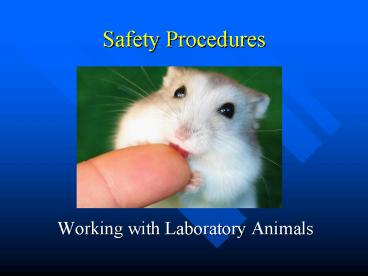Safety Procedures - PowerPoint PPT Presentation
1 / 41
Title: Safety Procedures
1
Safety Procedures
- Working with Laboratory Animals
2
University Animal CareDepartment
- Faculty and Student Resources
- Personal Protective Equipment
- Technical Training and Project Support
- Guidance with and Handling of Protocol
Submissions - Laboratory Animal Occupational Health Program
(LAOHP)
3
Ethics of Working with Laboratory Animals
- Animal Use Protocols and IACUC Review
- Humane Care and Treatment of Animals
- Reporting Concerns
4
(No Transcript)
5
(No Transcript)
6
Institutional Animal Care and Use Committee
- Must approve all vertebrate animal work before
the project commences - Adhere to government standards
- for protocol review
- Function and Composition
7
PROTOCOL REVIEW PROCESS
8
Protocol Review Criteria
- Humane Care and Use of Animals
- Reduction, Replacement, and Refinement
- Personnel Training and
- Experience
- Personnel Safety and
- Risk Assessment
9
(No Transcript)
10
Working with Laboratory Animals
- No Eating, Drinking, Smoking
- Pen/Nail/Gum Chewing or
- Applying Cosmetics.
- Wash Hands Routinely
- Exercise UNIVERSAL PRECAUTION
11
Working with Laboratory Animals
- Use Common Sense and Communicate
- EXPECT the Unexpected
- Be Mature, Professional
- and Respectful
12
Personnel Training Resources
- Radiological Safety Training
- MRI Equipment Training
- Chemical Safety MSDS
- Biosafety Training
- Animal Care and Use Training
13
Personal Protective Equipment
- Lab Coats or Scrub Attire
- Gloves and Gauntlets
- Masks and Respirators
- Goggles and Splash Guards
- Sterile Approach (Aseptic Technique)
14
Lab Coats and Gloves
- Both should be worn when handling live animals or
their tissues (BSL-1) - Gloves to be removed at work station
- NEVER to be worn in the hallway or while using
the telephone - Shoe covers when working with isotopes
15
Masks and Respirators
- Guards Against Zoonotic Airborne Diseases (e.g.,
Hanta virus) - Reduces exposure to Animal Allergens
- Reduces Exposure to Hazardous Vapors
- N-95, N-99 or N-100 respirator
16
Eye Protection and Goggles
- Working with Aquatic Animals or Primates
- BSL 2, 3 4 Areas
- Performing Invasive Surgery
- Handling Hazardous Samples
17
Animal Room Considerations
- NOTE EXTERIOR POSTINGS CAGE CARDS
- WEAR APPROPRIATE PPE
- USE LAMINAR FLOW HOODS WHEN HANDLING ANIMALS
- KEEP NOISE TO A MINIMUM
18
(No Transcript)
19
(No Transcript)
20
Handling Laboratory Animals
- Transporting animals
- Handle in a secure, quiet location
- Do not leave animals unattended!!
- Consider the use of guards or muzzles
21
Restraint Techniques
- Manual Restraint
- Chemical Restraint
- Mechanical Restraint
22
Laboratory Considerations
- DEDICATED HANDLING AREAS
- POST STANDARD OPERATING PROCEDURES
- SANITIZE AND MONITOR BENCHES
- LABEL SAMPLES WASTE
23
(No Transcript)
24
Understanding Syringes
- Barrel and Plunger
- Luer Fit and Luer Locking
- Units of Measure
- Drawing-up Compounds
25
(No Transcript)
26
Guide to Hypodermic Needles
- Gauges (14 31ga)
- Color Coding
- Luer fitting
- Uncapping
27
Recapping of Needles
- When is it Appropriate?
- What to do
- What not to do
28
Handling Biohazardous Waste
- SHARPS
- Needles, Razors and Lancets
- Pipette Tips and Broken Glass
- Anything that might permeate a bag
- Sharps Container (Radioactive Type)
29
Handling Biohazardous Waste
- TISSUES
- Animal Carcasses
- Blood and Serum
- Specimens and Fixatives
- Placed into a Dedicated Disposal Cooler
30
(No Transcript)
31
Handling Biohazardous Waste
- CONTAMINTED REFUSE
- Exam and Surgical Gloves
- Disposable Materials Contaminated with Bodily
Fluid or Excreta - Decontaminate Prior to Disposal?
- Biohazard Bin and Radio-waste Types
32
Handling Biohazardous Waste
- REUSABLE MATERIALS
- Surgical Instruments and Workstation
- Decontamination Procedures
- Hypo-chlorites, Quaternary Ammoniums
33
Animal Exposures
- Bites, Scratches or
- Needle Sticks
- Insect Vectors
- Apply First Aid and
Notify Instructor or
Advisor - Go to Student Health Center or Emergency Room
34
Lab Animal Occupational Health Program
- Participation may be required by the IACUC
- Project health risk categories 1, 2 and 3
- 2-sided form to be completed (UAC office)
- Clearance by SHS physician
- Informative resources
35
Field Studies
36
Field Considerations
- BE PREPARED
- FOLLOW SOPS
- READ POSTINGS
- REPORT BITES EXPOSURES
- CARRY PERMITS CELL PHONE
37
Field Preparedness
38
Read Postings
39
Project-Related Risks
Inherent Risks
40
Unanticipated Risks
41
(No Transcript)
42
(No Transcript)
43
(No Transcript)
44
University Animal CareDuncan Hall room 244
- Larry Young, RVT, LATg
- Operations Manager
- 924-4929
- Devon Miracle, RVT
- Veterinary Nurse
- 924-6525































